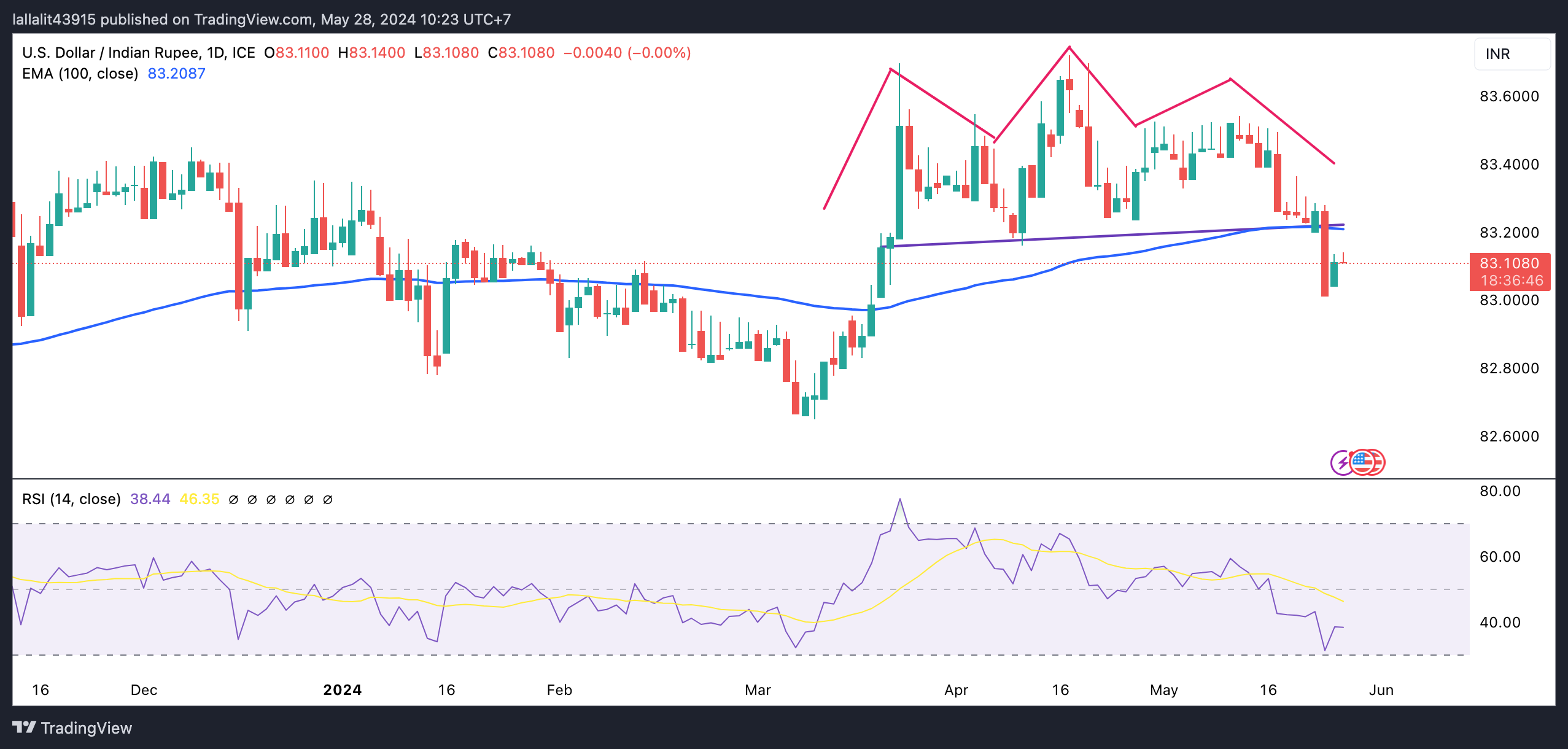USD/INR loses momentum, optimism in Indian equities boosts Indian Rupee
- Indian Rupee holds positive ground on Tuesday.
- The weaker USD and foreign flows into Indian equities created a headwind for USD/INR.
- Traders await India’s Q4 GDP and US PCE inflation data, which are due on Friday.
Indian Rupee (INR) trades in positive territory on Tuesday on a softer US dollar (USD). The appreciation of the INR is backed by a positive trend in domestic equities, with the country’s benchmark indices reaching new peaks. Foreign flows into Indian equities are expected to be a significant driver for the INR this week as investors await the outcome of India's general elections on June 4.
Investors will closely monitor the release of India’s Gross Domestic Product (GDP) for the fourth quarter of 2023 on Friday, which is estimated to moderate to 6.7% in Q4 from the previous reading of 8.4%. In case of weaker-than-expected growth, this could exert some pressure on the Indian Rupee. On the US docket, the final reading of the Personal Consumption Expenditures Price Index (PCE) for April will be in the spotlight on Friday. The hotter-than-expected PCE inflation data could lower the expectation of Fed rate cuts and boost the Greenback.
Daily Digest Market Movers: Indian Rupee remains firm due to strong foreign inflows into Indian equities
- Indian equity indices registered strong gains, with BSE Sensex and Nifty 50 hitting fresh record highs but ended the session in the red.
- Despite negative foreign fund flows in most emerging markets, India continues to attract large investments, owing to strong ETF inflows and positive investor sentiment, according to a research by Kotak Institutional Equities (KIE).
- India's economy is likely to grow at its slowest pace in a year in the first quarter due to weak demand, according to a Reuters poll.
- Gazan officials said on Monday that an Israeli airstrike triggered a fire that killed 45 people in a tent camp in the Gazan city of Rafah. Global leaders called for the implementation of a World Court order to halt Israel's attacks, per Reuters.
- Investors are now pricing in 34 basis points (bps) of the Federal Reserve (Fed) rate cut over 2024, down from nearly 50 bps of cuts expected earlier this month.
- The US Core Personal Consumption Expenditures Price Index (Core PCE), is estimated to show an increase of 0.3% MoM and 2.8% YoY in April.
Technical analysis: USD/INR turns bearish on the daily chart
The Indian Rupee trades stronger on the day. The USD/INR pair resumes a bearish outlook after breaking below the neckline of the Head and Shoulders pattern last week. The path of least resistance is to the downside as the pair holds below the key 100-day Exponential Moving Average (EMA) on the daily chart, and the 14-day Relative Strength Index (RSI) stands in bearish territory around 37.80.
The potential upside barrier for USD/INR will emerge near the support-turned-resistance level and the 100-day EMA at 83.20. Sustained rallies could expose a high of May 13 at 83.54 en route to a high of April 17 at 83.72, and then the 84.00 psychological level.
On the downside, a decisive break below the 83.00 round mark could drag the pair to the next downside target near a low of January 15 at 82.78. The additional downside filter to watch is a low of March 11 at 82.65.

US Dollar price today
The table below shows the percentage change of US Dollar (USD) against listed major currencies today. US Dollar was the weakest against the Australian Dollar.
| USD | EUR | GBP | CAD | AUD | JPY | NZD | CHF | |
| USD | -0.17% | -0.08% | -0.10% | -0.27% | -0.15% | -0.18% | -0.16% | |
| EUR | 0.16% | 0.08% | 0.06% | -0.10% | 0.03% | -0.02% | 0.02% | |
| GBP | 0.08% | -0.08% | -0.02% | -0.18% | -0.06% | -0.10% | -0.07% | |
| CAD | 0.10% | -0.06% | 0.02% | -0.15% | -0.04% | -0.08% | -0.05% | |
| AUD | 0.27% | 0.09% | 0.17% | 0.17% | 0.13% | 0.09% | 0.12% | |
| JPY | 0.14% | -0.03% | 0.06% | 0.01% | -0.14% | -0.04% | -0.01% | |
| NZD | 0.18% | 0.02% | 0.10% | 0.07% | -0.09% | 0.05% | 0.04% | |
| CHF | 0.16% | 0.00% | 0.08% | 0.07% | -0.07% | 0.03% | -0.01% |
The heat map shows percentage changes of major currencies against each other. The base currency is picked from the left column, while the quote currency is picked from the top row. For example, if you pick the Euro from the left column and move along the horizontal line to the Japanese Yen, the percentage change displayed in the box will represent EUR (base)/JPY (quote).
Indian Rupee FAQs
The Indian Rupee (INR) is one of the most sensitive currencies to external factors. The price of Crude Oil (the country is highly dependent on imported Oil), the value of the US Dollar – most trade is conducted in USD – and the level of foreign investment, are all influential. Direct intervention by the Reserve Bank of India (RBI) in FX markets to keep the exchange rate stable, as well as the level of interest rates set by the RBI, are further major influencing factors on the Rupee.
The Reserve Bank of India (RBI) actively intervenes in forex markets to maintain a stable exchange rate, to help facilitate trade. In addition, the RBI tries to maintain the inflation rate at its 4% target by adjusting interest rates. Higher interest rates usually strengthen the Rupee. This is due to the role of the ‘carry trade’ in which investors borrow in countries with lower interest rates so as to place their money in countries’ offering relatively higher interest rates and profit from the difference.
Macroeconomic factors that influence the value of the Rupee include inflation, interest rates, the economic growth rate (GDP), the balance of trade, and inflows from foreign investment. A higher growth rate can lead to more overseas investment, pushing up demand for the Rupee. A less negative balance of trade will eventually lead to a stronger Rupee. Higher interest rates, especially real rates (interest rates less inflation) are also positive for the Rupee. A risk-on environment can lead to greater inflows of Foreign Direct and Indirect Investment (FDI and FII), which also benefit the Rupee.
Higher inflation, particularly, if it is comparatively higher than India’s peers, is generally negative for the currency as it reflects devaluation through oversupply. Inflation also increases the cost of exports, leading to more Rupees being sold to purchase foreign imports, which is Rupee-negative. At the same time, higher inflation usually leads to the Reserve Bank of India (RBI) raising interest rates and this can be positive for the Rupee, due to increased demand from international investors. The opposite effect is true of lower inflation.



